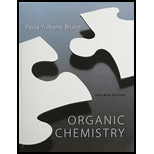
Concept explainers
(a)
Interpretation:
The product structures of should be drawn in
Concept Introduction:
The
An E2 reaction is a concerted, one-step reaction in which the proton and the halide ion are removed in the same step.
For
A good nucleophile/strong base favors
In primary alkyl halides substitution take place.
In secondary alkyl halides substitution and elimination take place (strong. bulky bases and high temperatures favor elimination over substitution).
In tertiary alkyl halides only elimination takes place
(b)
Interpretation:
The product structures of should be drawn in
Concept Introduction:
The
An E2 reaction is a concerted, one-step reaction in which the proton and the halide ion are removed in the same step.
For alkyl halide (tertiary, benzylic, and allylic) that can undergo both
A good nucleophile/strong base favors
In primary alkyl halides substitution take place.
In secondary alkyl halides substitution and elimination take place (strong. bulky bases and high temperatures favor elimination over substitution).
In tertiary alkyl halides only elimination takes place.
Want to see the full answer?
Check out a sample textbook solution
Chapter 10 Solutions
Organic Chemistry & Study Guide and Student Solutions Manual for Organic Chemistry, Books a la Carte Edition (7th Edition)
- Consider the E1 reaction of 3-bromo-2-cyclohexyl-butane. How many elimination products are possible? Include (E)/(Z) isomers as separate products.arrow_forwardWhich of the following reagent best accomplish this transformation below? a. Li/NH3 b. H2SO4, H2O, HgSO4 c. BH3, THF d. potassium permanganatearrow_forwardArrange the following alkyl halides in increasing reactivity in E1 reaction. Write 1 for the least reactive, then 2 and 3 for the most reactive A. 2,3-dimethyl-2-chloro-hexane B. 5-ethyl-3,3-dimethyl-1-chloroheptane C. 4-bromo-1-ethyl-2-nitrocyclohexane Answer: A. ____ B. ____ C. ____arrow_forward
- Arrange the following alkyl halides in increasing reactivity in E1 reaction. Write 1 for the least reactive, then 2 and 3 for the most reactive 1. 2,3-dimethyl-2-chloro-hexane 2. 5-ethyl-3,3-dimethyl-1-chloroheptane 3. 4-bromo-1-ethyl-2-nitrocyclohexane Answer: 1. 2. 3.arrow_forwardBased on your knowledge in biological chemistry reaction in biomolecules, what do you think is the best type and product for the above reaction? a. SN1 b. SN2 c. E1 d. E2 e. None of the abovearrow_forwardChoose the best reagents from the list provided below for carrying out the following conversion. Match the reagent with the step number. HCl (aq), Zn(Hg) KMnO4, H3O+ CH3Cl, AlCl3 HNO3, H2SO4 Cl2, FeCl3 fuming sulfuric acidarrow_forward
- Draw a reaction with reactant(s) and expected product(s) for each of the 6 alkyl halides in the SN1 reaction. If no product formed for any of the reactions indicates no reaction . In SN1 1% silver nitrate in ethanol was used to react with 6 alkyl halids 1-chlorobutane, 2-chlorobutane, Allyl chloride, 2-chloro-2-methylpropane, 1-chloro-2-methylpropane, 2-bromobutanearrow_forward2) Draw and name the organic compound found in every reaction. d) Reaction of cis-3,3-Dimethyl-4-propylocta-1,5-diene with two mole of HBr e) Reaction of trans-1-Bromo-3-chlorocyclopentane with potassium hydroxide f) Formation of Gilman reagent using isopropyl bromide g) Ozonolysis of 3,3-Dimethyloct-4-yne h) Complete halogenation (Cl2) of 3-Ethyl-5-methyl-1,6,8-decatriyne i) Partial hydrogenation using Lindlar's Catalyst 2,2,5,5-Tetramethylhex-3-yne j) Reaction of 3,4-Dimethylcyclodecyne with sodium amidearrow_forwardWhat is the worse base for E2 reaction 2-chloro-2-methylpentane? Select one: a. n-pentoxide b. iso-pentoxide c. iso-butoxide d. t-butoxidearrow_forward
- [IV1] Instructions: Follow the flow of electrons indicated by the curved arrows in each of the following reactions, and predict the products that result: (refer to the photo below)arrow_forward6. Identify the best reagent(s) for this reaction. (see attached screenshot). a. H2SO4, HgSO4, H2O b. 1. Disiamylborane, 2. HO–, H2O2 c. K2Cr2O7, H+ d. NaOCl e. H2, Pdarrow_forwardPredict the major products of the following reactions.(a) 1@ethylcycloheptene + ozone, then (CH3)2S(b) 1@ethylcycloheptene + warm, concentrated KMnO4(c) 1@ethylcycloheptene + cold, dilute KMnO4arrow_forward
 Organic Chemistry: A Guided InquiryChemistryISBN:9780618974122Author:Andrei StraumanisPublisher:Cengage Learning
Organic Chemistry: A Guided InquiryChemistryISBN:9780618974122Author:Andrei StraumanisPublisher:Cengage Learning
